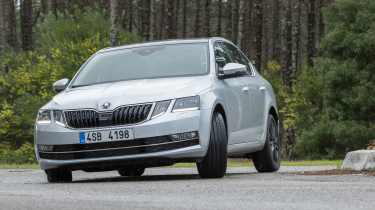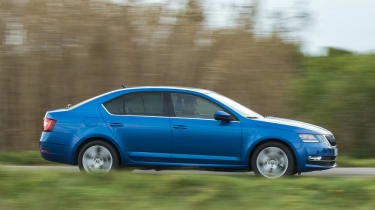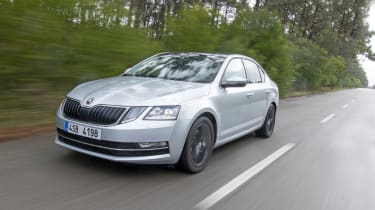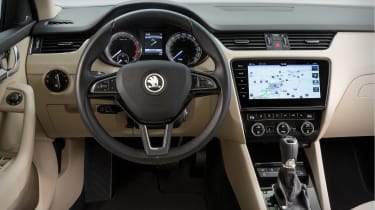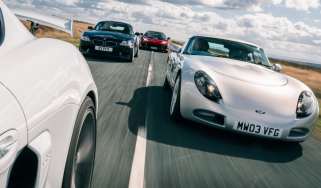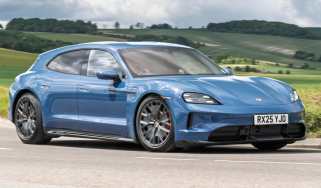2017 Skoda Octavia review - Facelifted hatch driven
Updated Octavia continues to impress, if not excite
Skoda says that to call the 2017 Octavia 'just a facelift' is to understate the changes it's made to its best-selling car. Skoda is probably overstating things, as this is very much a facelift of the existing Octavia, and one that, if feedback from evo's Facebook and Twitter channels is anything to go by, hasn't been the most successful in visual terms.
But the old Octavia was always a thoroughly competent car, if not an exciting one beyond the obvious vRS models. Our vRS drive will take place in the spring; in the meantime, here's what to expect from the regular updated Octavia range.
Engine, transmission and 0-60 time
The Octavia engine lineup comprises 1.6 and 2-litre TDI four-cylinder diesel models, and 1-litre and 1.4-litre TSI turbocharged petrols - the former with three cylinders, the latter an inline four.
All but the 1.6 TDI come with a six-speed manual gearbox as standard (the 1.6 uses a five-speeder), with a six-speed DSG available on every engine, depending on trim level. All-wheel drive can also be specified with the 2.0 TDI Estate in SE L and Laurin & Klement lines, while it's standard on the Scout.
Both the 1.0 and 1.6 engines develop 113bhp, with 148lb ft of torque at 2000rpm and 184lb ft at 1500rpm respectively. Contrary to these figures, we'd say the petrol feels the stronger of the pair - probably helped by its 6-speed manual, rather than the 5-speed - and the on-paper figures back this up, at 9.9sec to 62mph versus the diesel's 10.8sec.
The 1.4 and 2.0 also share a power output, despite their different fuels: 148bhp. The diesel again has more torque, with 251lb ft at 1750rpm to the TSI's 184lb ft at 1500rpm. And once again, the petrol is the quicker car, reaching 62mph in 8.1sec from rest, to the TDI's 8.5sec. The TDI 4x4 is actually a little less brisk, covering 0-62mph in 9.1sec.
More reviews
In-depth reviews
Reviews
- Skoda Octavia vRS 2025 review – the ultimate accessible Q car?
- Skoda Octavia vRS iV plug-in hybrid 2020 review – eco stealth
- Skoda Octavia vRS Estate review
- Skoda Octavia vRS 245 review - the hottest Octavia gets hotter
- 2017 Skoda Octavia vRS review - bigger and cheaper than a Golf GTI, but better?
- Skoda Octavia vRS 4x4 review - extra traction for extra fun?
Scout models have a 181bhp version of the 2.0 TDI, which will continue to be offered in the vRS.
Technical highlights
Changes to the latest car are minimal. Most significant is an increase in body length (11mm hatch, 8mm estate) and 20mm extra rear track, but the track changes are so slight that Skoda doesn't actually claim any benefits.
What's it like to drive?
Without wishing to incur the wrath of Skoda engineers who've spent the last few years painstakingly perfecting each and every aspect of the facelifted Octavia, the fact is that the 2017 model is largely identical to the car it replaces, new engine options excepted.
To be fair, little about the old car needed fixing. It's never been the sportiest of devices - that's what the vRS is for, after all - so regular Octavias are left to the job of being refined, undemanding to drive, yet conducting themselves in a manner that suggests a car of greater class than the Skoda badge implies.
Some things make themselves apparent immediately: The ride is mature, dealing with rough surfaces well without feeling too floaty if you surprise the car with a corner. The steering is good too - it has a smooth, friction-free feel and accurate responses. Very little road feel makes its way through the rim, but the way steering effort increases with cornering load is very natural, which is an acceptable surrogate for proper feedback. It's also as grippy as you're likely to need given each car's performance.
We tried three engine and transmission combinations - a 1.6 TDI with a five-speed manual (frugal, lethargic, unsatisfying: you wouldn't like it, so we won't waste your time), a 2-litre TDI with a six-speed DSG and all-wheel drive, and the recently-introduced 1-litre TSI petrol with a six-speed manual.
As is increasingly the case, the three-cylinder TSI proved the sweetest of the bunch. It won't satiate speed freaks but what it lacks in performance it makes up for in enthusiasm, and the bubbly little three-pot adds a layer of character you'd not expect to find in a car of this type. It settles down to almost silence at a cruise and doesn't filter vibrations back into the cabin, but you'd enjoy spinning it to the red line on every journey. Fun, but probably ruinous for economy...
> Read our full Skoda Octavia vRS review here
Most will probably end up buying (or more accurately, being given) the 2-litre TDI though. A less powerful version of the unit found in our previous vRS long-termer, it neither sounds as sporty nor feels as punchy as the vRS, but the DSG 'box does feel better matched than it used to - in its automatic mode, changes seem calibrated to use the unit's substantial torque, rather than dropping two or three ratios as if it was attached to a petrol engine.
Bottom line: The Octavia isn't a car you'll take out for a weekend thrash (at least in non-vRS trim), but if you're forced into one as part of a company car scheme you probably shouldn't sulk too much.
Price and rivals
Opt for the 1.0 TSI hatchback in S trim and the Octavia range begins at £17,055. You'll pay similar for superminis these days so Skoda still clearly represents good value, especially considering just how much space the Octavia offers. DSG adds £1250 across the range and trading up to the Estate is a £1200 jump.
1.6-litre diesel Octavias begin at £19,145 in S trim, the 1.4 TSI is £19,370 starting as an SE, and the 2.0 TDI is £21,170, also in SE spec. The cheapest 4x4 is the 2.0 TDI 4x4 Estate, at £28,855. Scout models start at £26,525, while the upcoming vRS starts from £25,130 - which also seems like good value, considering a five-door Golf GTI is £28,520.
The Octavia's list of possible rivals is vast, but few in the Skoda's price range are quite as substantially-sized. One that gets close is the new Honda Civic, tested recently and also offered with an energetic 1-litre three-cylinder engine. The Civic feels the sportier of the pair, the Skoda more grown-up, but both are worth a look if you're after a well-built and sizeable family car.

